Special Hobby 1/32 P-36A and Hawk 75
The Curtiss P-36 began with the Model 75 project, originally developed in 1934 by Curtiss' Chief Designer Don Berlin as the Curtiss response to the US Army Air Corps Request For Proposals for an all-metal monoplane pursuit aircraft, with a competition between prototypes scheduled for May, 1935. Unfortunately, it was decided that the prototype would be powered by the completely-unsuccessful 900 hp Wright XR-1670-5 twin-row air-cooled radial.
Curtiss submitted the Model 75 to the USAAC Material Division's single seat fighter competition on May 27, 1935. The fly-off was to be held that very month, but, the Model 75 was the only competitor ready. The two-seat Seversky SEV-2XP - the primary competitor - had been "heavily damaged" during delivery to Wright Field, and did not officially arrive there until June 18, 1935, though it was soon returned to the factory where it was redesigned to become a single seater with retractable undercarriage. The Air Corps delayed the competition until the SEV-1XP arrived at Wright Field on August 15, 1935. The only other serious competitor - the Northrop 2A - took off on its first flight on July 30, when it flew out over the Pacific, and disappeared into thin air, never to be seen again.
The competition was finally held in 1936. Curtiss lost to the Seversky prototype, which was ordered by the Air Corps as the P-35, which would eventually lead to the P-47 Thunderbolt. Curtiss protested that the delay gave the Seversky prototype an unfair advantage, and convinced the Army that it should defer its decision until after a further competitive evaluation which was to take place in April of 1936. Curtiss re-engined the prototype with the excellent Pratt and Whitney R-1830 and came back in 1936 to become the real winner, with 227 examples sold to the USAAC - the largest single order for an American fighter since the First World War, mostly due to the Air Corps' realization the Seversky had no ability to produce their “winner” in the numbers needed.
The P-36A had a 1,050 h.p. Pratt & Whitney R-1830-13 Twin Wasp engine driving a Curtiss Electric constant speed propeller. Maximum speed was 300 mph at 10,000 feet, with a normal range of 825 miles. Initial climb rate was 3400 feet/minute, and 15,000 feet could be attained in 4.8 minutes, while service ceiling was 33,000 feet.
While the P-36/Hawk 75 series have mistakenly been considered a "dud" by uninformed people, the airplane gave a good account of itself in service with four different air forces on both sides of the conflict. My friends Steve Hinton and Stephen Grey, who have had numerous opportunities to fly all varieties of Curtiss fighters, told me that of all, the P-36 is the nicest-flying, with finger-light handling. The late Erik Shilling, who flew them pre-war in the 8th Pursuit Group, also liked the airplane for its handling. This was also the report of the British A&AEE in 1940, when they tested a former French Hawk-75 and judged it more maneuverable than a Spitfire I; Kyosti Karhili, the top-scoring Finnish pilot in the Hawk 75, told me his only complaint was it wasn't as fast as a "Mersu" (Finnish 109) and the armament was "too light."
The 20th Pursuit Group at Barksdale Field, Louisiana, was designated the first recipient of the new P-36A, and they had relinquished their Boeing P-26s and sent them on to the 18th Pursuit Group in Hawaii while preparing to accept deliveries of the new fighter. However, the P-36As encountered extensive teething troubles almost as soon as they reached the unit. Severe skin buckling around the gear wells dictated increased skin thicknesses and reinforcing webs, while exhaust difficulties and weaknesses in the fuselage structure were encountered. Despite production line and field fixes, the P-36As were grounded again and again. In early 1938, the 20th PG was down to six serviceable P-36As, and even these had to be flown under severe limitations on speed, aerobatics, and combat maneuvers.
The 1st Pursuit Group had also been scheduled for conversion to the P-36A in 1938. They were forced to await the efforts being made by Curtiss to solve out the new fighter's problems. In the end, only the 94th Squadron received any P-36As during 1938, operating them alongside P-35s. The 27th Squadron obtained a few P-36As during early 1939, but neither squadron ever received a full complement of P-36As, the balance being made up by P-35s.
In 1939, the 8th Pursuit Group at Langley Field, Virginia was equipped with P-36s. In 1940, the 18th Pursuit Group in Hawaii was re-equipped with P-36s from the 20th PG when they moved on to the P-40B, subsequently passing their airplanes on to the 15th Pursuit Group, which flew their P-36s during the Japanese attack on Pearl Harbor, the only combat use of the P-36 by American units.
Curtiss had always been known for maximizing the export potential of their designs, and the Hawk 75 was no exception. The French Air Force found itself after the Munich Crisis in the unenviable position of having two of its most advanced fighter designs fail to achieve their performance goals at the moment they were needed most. While the prices quoted by Curtiss were nearly twice what the French thought the fighter was worth, and was more than twice as expensive as domestic designs, it had the benefit of being proven and available. Curtiss convinced the French Government to invest in a second factory in Buffalo to insure promised delivery dates, and began delivering the Hawk 75A-1 - equivalent of the USAAC P-36C Hawk - in the Spring of 1939. By the time France surrendered a year later, 320 Hawk 75A-1, A-2 and A-3 aircraft had been delivered to the Armee de l'Air.
Numerically second to the Morane-Saulnier M.S. 406, the Hawk 75 equipped four Groupes de Chasse at the time of the German invasion on May 10, 1940. The pilots immediately discovered their airplane was inferior to the Bf-109E on all counts other than maneuverability and airframe strength, with the Bf-109E able to break off combat at will due to its appreciably higher speed, though the Hawk proved able to take punishment and still get home. French Hawk pilots shot down over 150 German aircraft in the five weeks they fought the Luftwaffe.
Czech Ace Frantisek Perina, who flew the Hawk 75A-3 with GC I/5 during the Battle of France, remembered the Hawk 75 as being “terrific.” “It was not as fast as the Messerschmitt, but it could outmaneuver any German aircraft. If one got on your tail, in one 360-degree turn you were behind him.”
Lieutenant Edmond Marin la Meslée of GC I/5 was the French Ace of Aces during the Battle of France. With 16 victories and 4 probables, he is the ranking ace in the Hawk 75 of any pilot in any air force.
Born in Valenciennes on February 5, 1912, Meslée entered law school in 1931 to please his family. Taking advantage of a government aviation program, he learned to fly at the Morane flight school, obtaining his pilot license August 11, 1931. Shortly thereafter, he volunteered for two years' service and entered the French Air Force school at Istres. After graduation, he was sent to the 2nd Fighter Regiment in Strasbourg with the rank of Second Lieutenant. In 1934, with his enlistment about to expire, he re-enlisted for two more years, but had to take a reduction in rank to Sergeant.
In October 1937, he was admitted to the French Air Force Academy and promoted again to Second Lieutenant upon graduation in 1939. He was then assigned to GC I/5, where Commanding Officer Captain Jacques Accart recognized his potential as a fighter pilot.
During the Phoney War period, Meslée shot down a Do 17 on January 11, 1940. On May 11, the day after the German attack in the West began, he shot down 3 German aircraft, then went on to shoot down one aircraft each on May 13, 15 and 16, three on May 18, and six more by June 10. On June 11, 1940, Meslée took command of the 1st Escadrille on the death of the previous commander..
GC I/5 remained in combat until June 25, when the unit evacuated to North Africa. GC I/5 downed 117 German aircraft, losing only four pilots, one of whom died of blood poisoning while in the hospital, and had the best record of any fighter unit in the Armeé de l'Air during the Battle of France.
Meslée remained with the unit through the Vichy period. After the Allied invasion of North Africa, he led the others in joining the Allies. They were first provided P-40s, then P-39s in the summer of 1943, carrying out patrols over the Mediterranean. He was promoted as Commandant of GC 1/5 Champagne on January 9, 1944. Re-equipping with the P-47 Thunderbolt that fall, they were transferred to Salon-de-Provence on September 30 to support the French and Allied forces pursuing the Germans along the Rhône River.
On December 29, the group moved on to Dôle during the fighting in the Colmar Pocket. Meslée was supposed to retire from active combat flying in February 1945, but insisted on going on one final mission. On February 4, 1945, he led a three-plane patrol, with Captain Rouquette leading two other Thunderbolts to provide top cover. Meslée's P-47s attacked a temporary bridge near Neuf Brisach. After this attack, he spotted a German truck column. Despite intense flak, he strafed the convoy. Returning to verify the results, he was hit by a 40 mm shell behind the armor plate. Mortally wounded with shrapnel in his neck, he crashed and his P-47 exploded at Rustenhart. Chief-Sergeant Uhry was also hit killed by flak, his P-47 crashing near that of his leader. Marin Meslée was buried where he crashed, memorialized with a marker in the shape of a French pilot's badge.
Following the Franco-German Armistice, almost all of the 200 Wright Cyclone-powered Hawk 75A-4s on order for the French were taken on charge by the RAF, since they had not yet been delivered from the manufacturer. The Cyclone-powered Hawk was the fastest of all, with a top speed of 323 mph, though the Cyclone was a much more troublesome engine than the Twin Wasp, with constant oil pressure trouble.
The 200 ex-French Hawk 75A-4s, along with 12 Hawk 75A-8s originally sold to Norway and 12 Hawk 75A-9s sold to Iran, were known as the Mohawk IV in RAF service. After being assembled in the UK and kept at Maintenance Units while there was danger of a German invasion, the Mohawks were sent overseas beginning in late 1941. 72 Mohawk IVs were used as fighter trainers in South Africa, though at least one SAAF squadron did use them for air defense of Capetown until 1943. Portugal invoked its ancient treaty of defense with Great Britain and 12 Mohawk IVs were supplied to the Portuguese Air Force where they equipped one fighter squadron in the Azores.
The remaining Mohawk IVs were sent India, where 5 Squadron RAF began equipping with the Mohawk IV in December 1941, providing the sole fighter defense of north-east India until May 1942. In March 1942, 146 Squadron equipped with Mohawk IVs. The two squadrons were joined by 155 Squadron in September 1942, forming the Mohawk Wing. The squadrons engaged in bomber escort, standing patrols and close support over the eastern India front and Burma. In January 1943, they began “Rhubarb” operations, sending flights of 2-4 fighters free-ranging over enemy territory at low altitude in bad weather, strafing whatever enemy activity they came across. The maneuverability of the Hawk 75 was put to good use on these operations, which frequently constituted the only offensive RAF operations during the monsoon season which began in May and lasted through October.
The Mohawk Wing was heavily engaged in ground-support operations during the heavy fighting following the Japanese invasion of Imphal in February-March 1943. 5 Squadron turned in their Mohawks for Hurricanes in June 1943, followed by 146 Squadron that October. 155 Squadron was the last Mohawk operator, exchanging their Mohawks for Spitfire VIIIs in January 1944. Six Ki.43 Hayabusa (Oscar) fighters were shot down by Mohawks during their escort and rhubarb missions, including two credited to the Mohawk IV “Joe Soap II,” which was operated by 155 Squadron.
In October 1940, Germany agreed to sell captured French Hawk fighters to Finland, and a total of 44 captured aircraft of five subtypes were sold (at commercial prices higher than those the French had complained of when they purchased the airplanes from Curtiss-Wright!), with three deliveries between June 23, 1941 to January 5, 1944. These included Twin-Wasp-powered H-75A-3s and Cyclone-powered H-75A-4s. Some Twin Wasp-powered H-75A-6s and Cyclone-powered H-78A-8s initially sold to Norway and captured in their wooden crates were sold to Finland in early 1941.
Originally assigned to Lentolaivue 14 and 16 for high-speed reconnaissance, the Hawk 75s were eventually flown by Lentolaivue 32 throughout their wartime service and were popular with Finnish pilots, who called it Sussu ("Sweetheart"). The Finns were the most successful operators of the Hawk 75 in combat, scoring 190.33 kills by 58 pilots, between July 16, 1941 and July 27, 1944, for the loss of 15 Hawks. After the Armistice, the survivors remained in service with HLeLv 13 and HLeLv 11 until 1948.
With 13.5 victories scored while flying the Hawk 75, Kyösti Karhila is the second-highest-scoring Hawk 75 pilot of the war. Karhila's father had fought during the Liberation War of 1918-19 that founded modern Finland, and the son felt it his duty to also serve. At age 16 in 1937, Karhila joined an Aero Club founded by the National Aviation Association and obtained his A and B glider licenses over the course of a month. In the summer of 1939, he completed 35 hours of powered flight training and became a reservist in the Finnish Air Force, where he began advanced flight training that fall, tarting his military service on December 6, 1939, Finnish Independence Day. With 84 other students, he trained while the Winter War raged, completing his training and receiving his wings just too late to see combat service.
Karhila had good memories of the Hawk compared with the Fokker D.XXI he had previously flown. “The Sussu was 50km/h faster, and had retractable undercarriage, along with a better armament. Performance - agility, climb - was better than the Fokker and the Sussu was maneuverable. Technically, it was the state of the art in those days, in our opinion.”
Karhila finally saw combat on July 31, 1941. As he remembered, “Major Ehrnrooth was going sight-seeing and asked for a volunteer wingman and he selected me. We set off to the air base of Suur-Merijoki, which was now in enemy hands. When we crossed the front, we were shot at by heavy AA, which was the first time for me. He was flying a Cyclone-powered airplane, and suddenly his oil temperature went up and he had to decrease power. We didn't have radios and I wondered why he flew so slowly. I kept a sharp lookout and spotted two dots behind us. I kept watching, and they were Russians - two Tchaikas, I-153's. Since our radios weren't working, I added power and went ahead of the Major and signalled him ‘follow me.'
“I turned against the enemy - they were diving on us from higher altitude. We turned against them heads-on and fired. That is the most unpleasant situation, since neither pilot knows which direction to dodge. If you do not dodge, you will be rammed, but if you dodge too early, they will get a chance to shoot at you. My Russian did not dodge and the Tchaika nearly rammed me. We both banked around and came back at each other. After the third turn he was gaining on me and I knew I was going to be in trouble. At about 2000 meters. I pushed over and dived. I looked behind to see the Tchaika tried to follow, but he was left behind. Then I returned to find my leader.
"Major Ehrnrooth had shot down the second Tchaika and shot it down. I joined on his wing, thinking I was in trouble, that I had abandoned my leader in the face of enemy. When we landed, I went to him and attempted to report. He slapped me on shoulders, and said, ‘That's the way, you saved us both!” He had no idea those Russians were near till I saw them, and he praised me to heaven.”
Karhila flew Hawk 75-A-4 CU-560 (which had originally been powered by the Cyclone, which was replaced by the more reliable Twin-Wasp) in which he scored 8 of his 13.5 victories in the Hawk. By early 1943,he was an experienced flight leader. On February 9, 1943, he took part in the ambush of a reconnaissance Pe-2. The Pe-2 was so fast a Hawk could only catch one if it had an altitude advantage sufficient to build up speed in a dive. “I managed to surprise a lone Pe-2. I hit a fuel line in the cockpit area, a fire broke out in the cockpit and two men bailed out while the Pe-2 crashed in a bog.”
In March 1943, with 13.5 victories scored in the Hawk 75, Karhila was transferred to HLeLv 34, commanded by Major Eino Luukkanen, where he transitioned to the Bf-109G.
The Kits:
Special Hobby's line of P-37/Hawk 75s om 1/32 are the best kits of this airplane. The kit is limited-run and presents some challenges that can be overcome with "some modeling skill required," with a nice result. I've built four of them - the P-36A, Hawk 75A-1 (Finnish), Hawk 75A-3 (French) and RAF Mohawk IV. While the P-36 and Mohawk IV was released by Special Hobby, the Hawk 75A was an Azur kit.
While the P-36 "Pearl Harbor Defender" kit is listed as a P-36A - which did not have wing guns - the kit comes with four machine gun barrels, the openings in the wing and the scribed detail for the gun bay covers, to do the 6-gun Hawk 75A-3. A modeler needs to fill in the holes on the wing leading edge and fill in the scribed panel detail for the gun bays to create a P-36A. The good news here is that it will also be possible to do the P-36C - which had a single gun in each wing - and this is important because the decal sheet includes the markings for Harry Winston's P-36C, which was not a P-36A as the kit instructions would have you believe. The decals are good, and result in models of the P-36s flown by the two pilots who scored on December 7: Rasmussen's P-36A still in pre-war polished natural metal and Winston's P-36C in Olive Drab and Neutral Grey. Fortunately, Cutting Edge created three very nice decal sheets for their Hawk 75 conversions, so you can do several pre-war P-36A's, a P-36C in the special war games camouflage from 1938, or several Hawk 75A-3s. Yellow Wings Decals has also released a sheet for the pre-war P-36A in markings for the 20th PG. I chose to use the Cutting Edge sheet that had "The Gold Bug," the P-36A flown by the commander of the 18th PG at Wheeler Field in 1940-41, which has a spectacular scheme of polished metal and gold paint.
The kit breaks down into three major sub-assemblies: the engine and cowling, the main fuselage with cockpit, and the wings. After the first one, I departed from the assembly procedure, which has you attach the engine and cowling to the fuselage before mating that sub-assembly to the wing, which led to some pretty severe fit problems the first time around. I did the others by assembling the wing, assembling the engine and cowling, then mounting the engine and cowling to the wing, which allowed me to work on the fit and get it right. You still will use plenty of putty and Mr. Surfacer to get these joints cleaned up, and I had to polish the daylights out of the first kit which was going to be painted in polished aluminum.
For the rest of the assembly, I used the same method on all four. I started with the cockpit, which is detailed sufficiently to look good. The photo-etch fret is from Eduard and is pre-painted. The kit comes with two different instrument panels, one for the export Hawks, so be careful to figure out which is which. I used instrument decals from a ProModeler sheet for the panel. The Eduard seat belts look good when used, but remember that USAAC aircraft of this period did not use shoulder harnesses, only lap belts .
The kit provides a good-looking Pratt & Whitney R-1830, which I painted and installed on the cowling bulkhead, then assembled the cowling after painting the interior light grey.
The wings need to have the panels for the wing guns and the associated holes filled for the P-36, but can be left alone for the others. I did this with cyanoacrylate glue to make sure they really did disappear, then gave them a coat of Mr. Surfacer 500 after sanding the area smooth.
The P-36/Hawk 75 used canvas "boots" in the wheel wells. After closely studying the Hawk 75A-1 when it was being restored at Fighter Rebuilders, I made the boots by taking paper towel, covering it with white glue, and then forming it over the cap of a bottle of Micro-Sol, since that was just a bit smaller in diameter than the wheel wells. When the glue dried, the paper towel pieces were removed from the caps and trimmed to fit inside the wells, with the result that they looked exactly like the "boots" I had seen on the restored Hawk 75A-1.
I used Floquil "Old Silver" lacquer for the Polished Aluminum on the P-36A and Tamiya "Gold" - "Old Silver" looks just like polished aluminum and is a paint that dries hard and stands up to being handled (unlike @#$#! Alclad, which I hate hate hate). The other three were painted using appropriate Tamiya and Xtracrylix paints for the camouflage schemes.
The Finnish Hawk 75 was completed with Cutting Edge decals, with the serial suitably modified to make Kyosti Karhili's airplane. The Hawk 75A-3 used kit decals, and the Mohawk IV was done with Cutting Edge decals, though the kit decals would have been OK.
I have included photos of the two restored flyable P-36/Hawk 75s, both of which were restored by Fighter Rebuilders at Chino. The Hawk 75A-1 was restored in 2004, while the P-36C (incidentally the last P-36C built) was completed in 2015. Having the good fortune to see both is one of the benefits of living an hour from Chino Airport, Warbird Central in the USA.
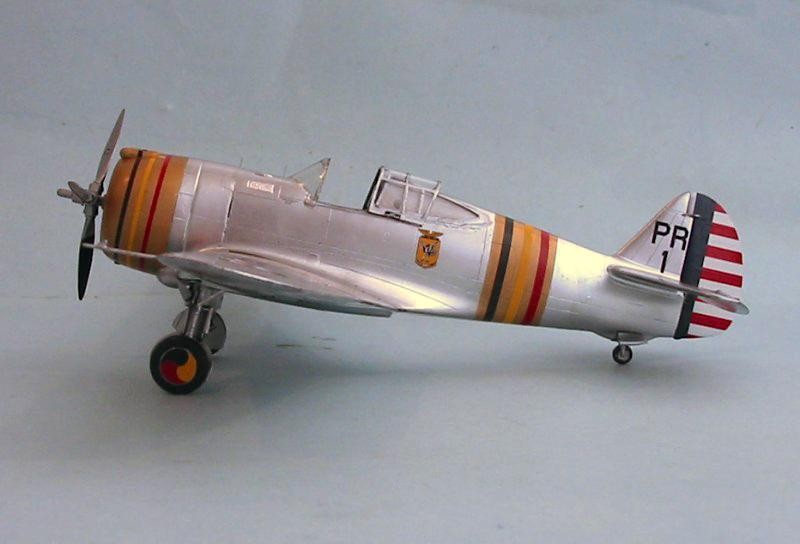
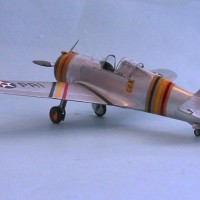
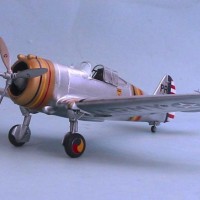
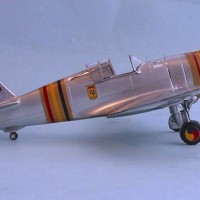
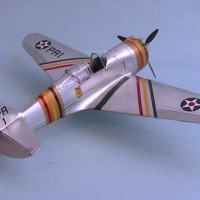
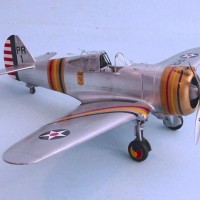

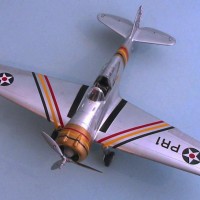

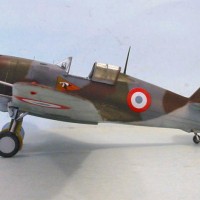
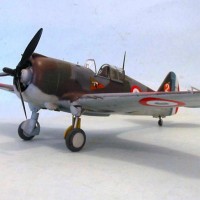

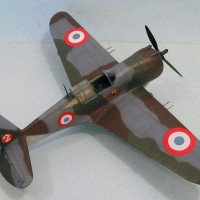
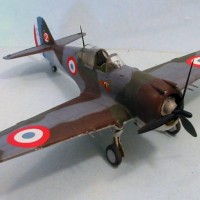

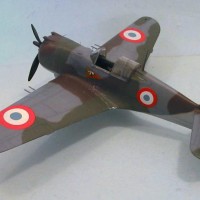
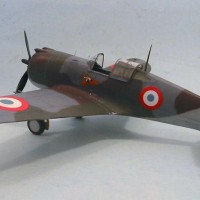
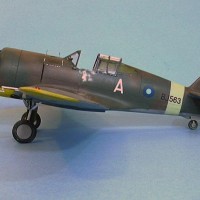
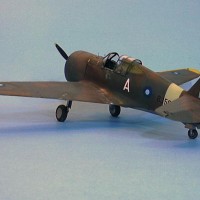
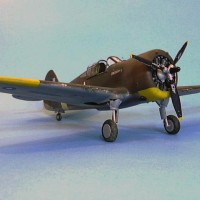
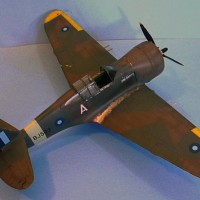


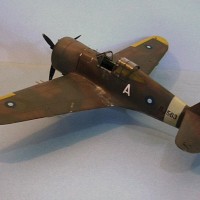


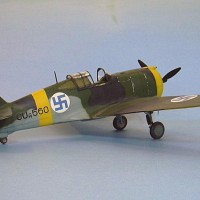
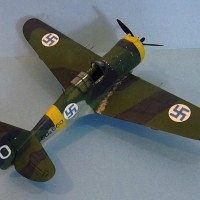

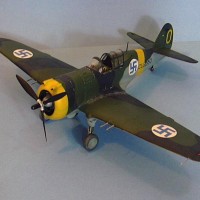
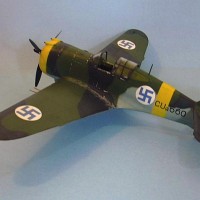
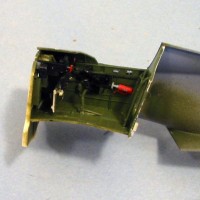
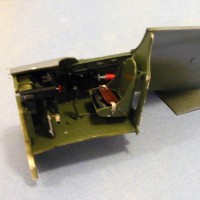
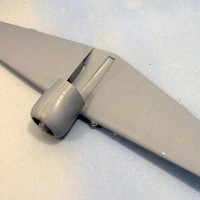
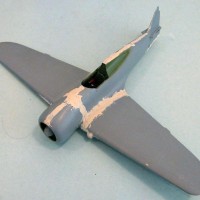
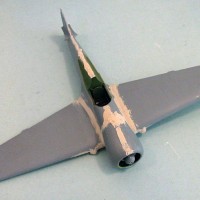
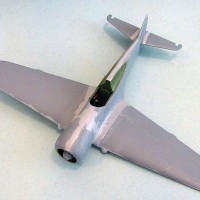

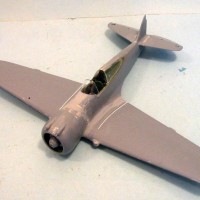

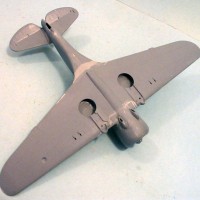
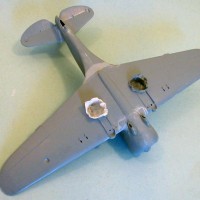

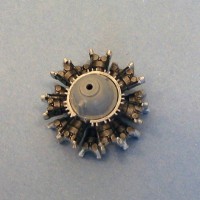
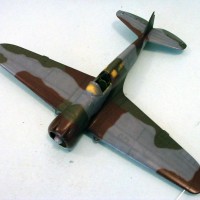

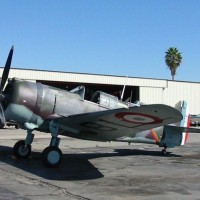
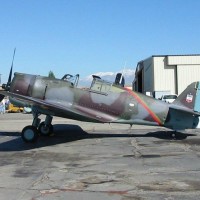
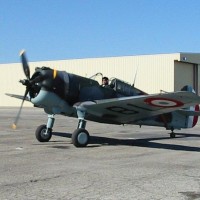


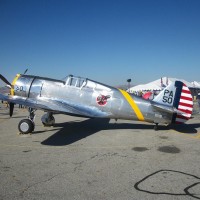
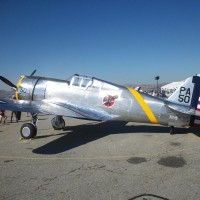
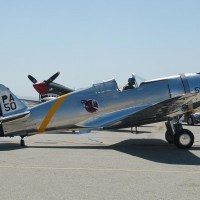
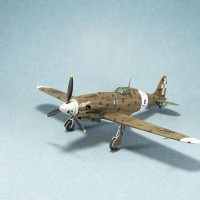

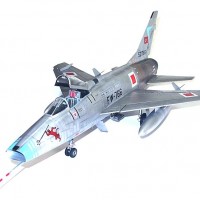
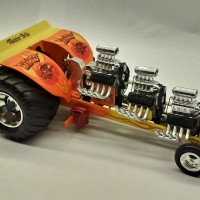
Very nice article with great history and usable build info. I hope a decent mainstream company produces a Hawk variant. I always love this airplane but never had a model of one. I considered the special hobby kit but I have been spoiled by building more modern, high-tech moldings offered by Tamiya and such. Have not built a SPecial Hobby since my 1/32 Buffalo. Great build with a good looking set of models..lots of work put into it. Thanx !
Informative post and extremely well done build and accompanying photos - nice job all around. I like everything about it. 🙂
Tom, thanks for the comprehensive rundown on the Curtiss Hawks. They really got around, and generally gave a good account of themselves for their various operators. Lots of different color schemes and markings. I've always been drawn to the Hawaiian one, supposedly the only use of gold paint in the Army Air Corps. The stripes denote the group commander.
Nice work, Tom. I did that gold trim scheme on my Hobbycraft kit when they came out.
Very nice! Love the Finnish livery - just one of my favorite WWII schemes.
Beautiful aircraft, Tom. Your history and photos of both your build AND the restored planes are great as usual.
Well done!
Nice builds, nice history, one wonders what would,ve been the result if they put a better radial in the P-36.
Just love those stripes.